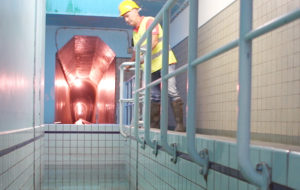06 November 2020
LACROIX Environment
District metering and leak detection in the SWDE’s drinking water network
The Société Wallonne Des Eaux (SWDE) is a state-owned company responsible for the production and distribution of drinking water in Wallonia. The water distribution network managed by the SWDE covers more than 36,000 km and supplies 2.5 million consumers across 200 different communes. Today, nearly 70% of the population of Wallonia receives its water from the SWDE.

The SWDE’s main objectives are to:
- produce drinking water while ensuring the long-term conservation of the resource through sustainable consumption,
- ensure the entire area receives a continuous supply of quality water while maintaining the quality of the water pressure,
- design and maintain production and distribution infrastructures
- guarantee that private, public and industrial customers are satisfied by anticipating and meeting their water needs.
To achieve its objectives, the SWDE focuses on making its production and distribution infrastructures as efficient as possible. In doing so, the water operator hopes to reduce its network operational costs and offer the most cost-effective water service to its customers.
To this end, one of the SWDE’s strategic objectives is to find and repair any leaks in the network as quickly as possible.
The SOFREL LS data logger plays a key role because it is what provides us with the data.
Benoît MOULIN SWDE Spokesperson

Testimonial
David BRUNET
Director of SWDE Network Performance
Denis DEVOS
Project Manager for Remote Meter Reading
-
You have deployed no fewer than 2,000 SOFREL LS data loggers in the network managed by Société Wallonne Des Eaux. What have they been able to do for you?
 Denis :
Denis :To be able to monitor the district metering points as closely as possible, we connected the LS data loggers to the flow rate meters responsible for measuring consumption. They record and store volumetric data and flow rates (e.g. max., min., average, etc.). The data loggers activate every day to send their data to our main system in GPRS/3G.
 David :
David :They provide us with fast data collection and do not require us to perform weekly manual readings of meters in the network as used to be the case.
With data loggers, readings are now performed automatically every 15 minutes.
 Denis :
Denis :We are especially interested in the night flow rate when looking for leakages. Between 2 a.m. and 4 a.m., the flow rates are at their lowest. If there is a sudden increase in consumption during this period, this is usually a sign of a leak.
Using the accurate data collected by the data loggers, our leak detection and repair teams can quickly and easily access the damaged area.
After the repair, we can look at the flow rate curves at the main station to see that the pattern has returned to normal. The leak has thus been repaired.
-
This saves you valuable time in detecting leaks.
 David :
David :The time between the reading, finding a sign of a leak and sending the repair teams has been significantly reduced. It is now possible to repair leaks in just a couple of days which used to take weeks to do.
The volumes of water lost has thus been greatly reduced.
4 million cubic meters of water saved in two years
The results were quickly apparent.
The SWDE has informed us that the district metering of networks and the continuous reading of flow rate indicators has helped them increase their productivity by 30% in leak detection. Since installing the equipment, they have saved 4 million cubic meters of water in two years.
According to their strategy plan, the company hopes to save €2,000,000 through leak detection by 2022.
As the volumes of water lost has decreased significantly, the investment in district metering has quickly paid for itself.
The operational costs have been greatly reduced. The SWDE wants consumers to share in this by passing on some of the savings to their water bills.
With the reduced operational costs being reflected in their bills, consumers will benefit from this.
Benoît MOULIN SWDE Spokesperson




